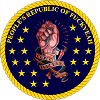With that in mind, I understand that the races of Star Wars, as they are depicted, far exceed in power the races of many other sci-fi races -- including all of those depicted in Star Trek.
I was thinking about science fiction races that might stand a chance against the Galactic Empire of Star Wars, and what sort of versus scenarios would make for interesting discussion and battles. I feel that Star Wars is fairly evenly matched with the video game Homeworld, though the Galactic Empire may have a few significant advantages... not the least of which is shielding.
First, some backstory. If you want to delve more specifically into the stats of the Homeworld races, I would suggest the Encyclopedia Hiigara (http://homeworld.wikia.com/wiki/Main_Page) an excellent resource on ship sizes and capabilites. For now, I will give a quick overview.
Homeworld is a Real-Time-Strategy game that was released by Relic in 1998. It was revolutionary in its day, in that it was one of the first games to depict strategy in 3D space. Unlike most other space-based strategy games, Homeworld allowed the player to manuver fleets on multiple planes, and in 3D volumes, with 3D formations and tactics. This made it a bit daunting for the average player, but it provided an incredible depth of strategy not seen in many games that came before or after. Homeworld focused on intense ship-to-ship combat in space involving various weapons platforms and sizes of ships, each of which had their own purposes and advantages. Homeworld also forced the player to rely on supply lines to gain resources, and he had to protect these supply lines or face running out of raw materials and even fuel. Homeworld had two sequels: Cataclysm, which added the ability to upgrade ships, set waypoints and attack strategies, and the concept of superweapons -- and Homeworld 2, which simplified the interface, increased the depth of ship upgrades and technologies, and added new classes of ships and weapons.
The universe of Homeworld takes place on a grand and galactic scale. The story focuses upon the struggles of galactic and regional powers in a single galaxy which is not assumed to be our own. The races of Homeworld, like the races of Star Wars, have been developing for thousands of years, and have the capability of raising massive fleets. I will not get much further into the backstory -- so please check out Ecyclopedia Hiigara for further details.
Here is a video (albeit of a mod,) which I think gives a pretty good depiction of the kinds of ships and technologies in the homeworld universe:
http://www.youtube.com/watch?v=lFVUoxPchgw
***TECHNOLOGY*
First, to compare the races of Homeworld to the races of Star Wars, we must compare their technology.
*STARSHIPS*
Homeworld starships are divided into several size classes: Strike Craft, Corvettes, Frigates, Destroyers, Cruisers, Carriers, Shipyards and Mother-Ships.
Strike craft are small, manuverable fighters and bombers capable of taking out smaller capital-class ships and providing a significant advantage to those who employ them. Corvettes are anti-strikecraft starships with turrets or missiles, which are heavily armored, but are incapable of taking out larger capital ships. Frigates trump corvettes, but are vulnerable to strike-craft. Frigates usually come in anti-corvette (multiple gun turrets or missiles), or anti-frigate varieties (with huge ion cannons.) Destroyers are the backbone of the fleet, and can easily take care of large collections of frigates and strike-craft. Cruisers are giant, slow, heavy-hitters of the fleet capable of destroying enemy assets, but are vulnerable to strike-craft. Carriers, Shipyards and motherships are heavily armored, giant factories, whose primary purpose is to resupply the fleet and provide a base of operations. Carriers, Shipyards and Motherships have very little weaponry, and must be defended by combat class ships. Carriers' primary purpose is to bring strike-craft into hyperspace to get them in range of the enemy.
*PROPULSION*
Homeworld ships rely on approximatley three types of propulsion. Small ships, such as fighter craft, rely on ejecting either a chemical or ion rocket trail. It is not entirely clear what sort of engines these are, but in Homeworld 1, they appeared to use fuel, which was propelled out of the back of the fighter, leaving a long trail of what appears to be smoke or ionized plasma. When the fighter craft was out of fuel, it would drift in space without any control. In Homeworld 2, fighters did not run out of fuel, and their engine trails appeared more clearly to be ionized plasma.
The second type of engine, used on ships all the way up from small corvettes to the massive "mother-ships" appears to be some kind of fusion-based plasma engine, and does not emit an ion trail.These engines provided enough thrust to move huge ships -- albeit with low acceleration, over large distances. Fighter craft are clearly more manuverable than capital ships, but they are greatly outranged by the bigger vessels. All of these propulsion methods seem quite inferior to Star Wars propulsion technologies.
The third type of engine is called a "hyperspace drive." The hyperspace drive appears to operate much in the same way as the hyperspace engines of Star Wars. Namely, the ship appears to enter another sort of space parallel to real space, called "hyper space", and then emerge back in real space a significant distance away. Also, similarly to Star Wars, ships can be "pulled out" of hyperspace by significantly large gravitational fields. Unlike Star Wars' depiction of hyperspace engines, Homeworld engines are huge and cumbersome, so only the largest capital ships have them. There are also various kinds of hyperspace engines. Some can only maintain a ship in hyperspace for a short amount of time before pulling the ship out of hyperspace, after which they must "recharge." These are really only good for interplanetary flight -- as it can take several hours in hyperspace to go thousands of light years. Therefore, hyperspace travel is done in "jumps," where ships will jump, emerge from hyperspace, recharge, and jump again. The largest hyperspace engines can manage travel accross the entire galaxy in perhaps a dozen such "jumps."
In addition, Homeworld hyperspace engines create a "wake" around the ship in which other objects can be caught and brought into hyperspace. In this manner, entire fleets can be transported acrross the entire galaxy if they remain in tight formation with a large "mother-ship" that carries a galactic hyperspace core.
Some of the races of the homeworld universe have significantly more advanced hyperspace technology. The "progenitors" (an ancient race which dissapeared from the homeworld universe 10,000 years earlier) were said to have had a hyperspace engine capable of jumping across the galaxy in less than a second, on a single jump. This same engine was said to have allowed the progenitors to perform inter-galactic travel.
*WEAPONRY*
The weaponry of homeworld is divided into a few main types.
---Mass Drivers---
Mass Drivers, such as railguns and cannons, are still in heavy use in the Homeworld universe. They come in various size classes. Strikecraft use what are essentially machine-guns or perhaps railguns to fire a continuous stream of high-velocity bullets at their targets. It is unclear exactly what these bullets are made of, but they are apparently able to pierce armor in even some of the larger capital ships. The second class of kinetic energy weapons -- the autocannons -- is made up of rapid-fire railguns capable of taking out strike craft and small ships. Above that, there are heavier railguns on the destroyers and cruisers which are truly heavy hitters. Getting energy data on these guns is very difficult, but the Taiidan in Homeworld 1 were seen to use them to great effect as orbital bombardment weapons, and in the game they are routinely used to destroy asteroids of considerable size.
>> A mass driver weapon:
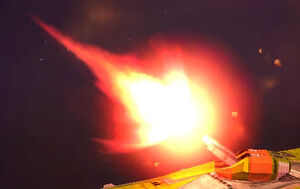
---Missiles---
In addition, missiles are in wide use in the Homeworld universe. The missiles depicted use the same drive technology as the strike craft, leaving a long ion trail. There are many kinds of missiles. Some are in the kiloton range, and are used against strike craft. Some are in the megaton range and are routinely used by frigates and cruisers. Larger, slower missiles are used by the biggest ships of the game, and appear to be in the hundreds of megaton to gigaton range, and are used against motherships and for orbital bombardment. Also, Homeworld fleets can employ intelligent mines, which sit inactively until a ship comes near, and then turn on their main engines to strike.
>>A "fusion missile" (apparently it employs thermonuclear fusion in its detonation)
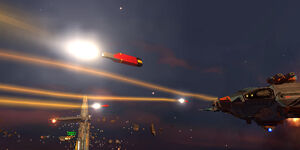
>>Anti strike craft missiles, from a multiple-vehicle launch platform.
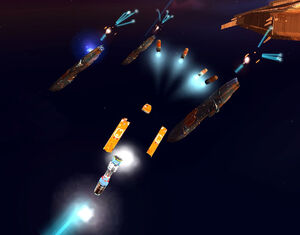
---Plasma Weapons---
Plasma weapons, such as the "plasma bomb",the "plasma autocannon" and some of the smaller plasma beam and "plasma lance" weapons are in limited use in the homeworld environment. Plasma weapons are depicted to be considerably more powerful than the mass drivers, but use similar delivery mechanisms.They are, however, less powerful than the missiles. Some plasma weapons are designed principally to disable ships' systems with EM radiation.
>>Strike craft launching plasma bombs

---Directed Energy Weapons---
The principal directed energy weapon of the homeworld universe is called the "Ion Cannon," this weapon appears to emit a beam of contained plasma or highly charged ions at its target at very near the speed of light. These weapons are difficult to aim, and use up huge amounts of energy and space, but their effect is nothing short of devestating on armor and asteroids. The "Planet Killers" of Homeworld 2 were essentially enormous ion cannons which were used, presumably, to destroy planets. (Although this is never actually depicted in the game.) Ion cannons are emplyed from the frigate up to the cruiser range, and are a significant threat to capital ships -- though not to strike craft. The second kind of directed energy weapon is called a "pulsar beam." Some of the pulsar beams depicted appear to infact be powerful lasers, while others are described as being "short pulse ion cannons," that is, they principally operate by storing up a large amount of energy in a capacitor, and then releasing it in a very short pulse in the form of an ion beam. These weapons are significantly smaller and more efficient than ion cannons, but they do considerably less damage. Pulsar beams are a significant threat to corvettes and slower bombers, as they have more power and accuracy than small mass drivers.
>>A Hiigaran Battlecruiser, firing its main Ion Cannon

---Super Weapons---
There are a few "super weapons" in the homeworld universe. Some are depicted as being "planet killers" (with various interpretations. Its not clear if these weapons can actually vapourize planets, or merely make it unlivable for the planet on the surface.) One particular weapon, the "seige cannon" is depicted to be able to destroy entire fleets of Homeworld ships in an intense blast of radiation, although it is not entirely clear how powerful this weapon is. Other superweapons, such as "Sajuuk," rely on scaled-up versions of the ion cannon, and are similar in operation to the Death Star's main beam.
>>Concept for a "planet killer"

>>A "Phased Cannon Array"
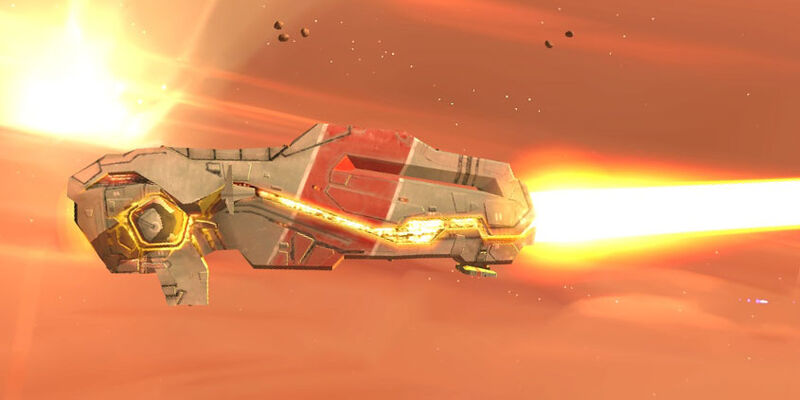
*SHIELDING AND ARMOR*
Here is where I believe that Homeworld is most at a disadvantage to Star Wars. Most of the ships depicted have very thick, apparently metallic armor, and if they have shielding at all, it is not readily visible. However, energy shields are certainly present in the universe. There are two types of energy shields depicted. One of them apparently uses the force of gravity or some other force to physically repel projectiles, missiles, and asteroids. It exerts its force over a wide area, and requires absurd amounts of power to run. It is therefore deployed only on a few "experimental" ships which essentially have their entire architechture devoted to the shield technology. These ships are not very useful, except for deflecting incoming fire from capital ships. They are ineffective at stopping ion beams. The second kind of shield is actually a kind of point defense system that detects incoming missiles, bullets, and ion cannons, and vaporizes them with a high intensity laser.
I do not think either of these would be very effective against Star Wars weapons.
*SENSORS*
Homeworld ships have a few main sensors, but unfortunately all of them appear to be slower-than-light in operation. They can detect things optically, using cloaked probes, they have some kind of EM detection scheme which can determine the positions and hull designs of ships at hundreds of thousands of kilometers, and they have gravitational sensors (named "proximity sensors") which are primarily used for detecting cloaked ships. All ships typically have quite a small bubble in which they can accuratley see and target enemy vessels.
*GROUND FORCES / ONSHIP COMBAT*
Homeworld fleets are typically equipped with "marine ships," and "infiltrators," whose role is apparently to board ships and take them by combat using infantry. This combat is not depicted in the game, so it is difficult to assess. In some of the cut-scenes, ground forces, tanks, and planetary weapons systems are visible.
>>A Vaygr Infiltrator frigate, with boarding shuttles visible

>>concept for ground vehicles
http://images2.wikia.nocookie.net/homew ... hicles.jpg
*STAR BASES*
In Homeworld, key locations are often guarded by enourmous space stations -- some the size of cities or small asteroids. Often, star bases are built into asteroids to reduce their cost and provide building material. Star bases rarely have much firepower. The "Progenitors" are said to have built "megaliths," which were huge star bases of incredible power, some the size of moons. These megaliths are visible in the background during some of the game, but they are never depicted as being in operation.
>>concept for a starbase in an asteroid:
http://images4.wikia.nocookie.net/homew ... 0403-j.jpg
>>concept for a megalith
http://images1.wikia.nocookie.net/homew ... -Karos.jpg
*SPECIAL TECHNOLOGIES*
Homeworld fleets also have a range of special technologies which might give them an advantage. One of these is the "Gravity Well Generator," which is capable of pulling ships out of hyperspace with a huge artificial gravity field that extends primarily into hyperspace. In addition, gravity well generators can be used to immobilize specific ships. Homeworld fleets also have access to tractor beams, but they are depicted to be of much shorter range than the tractor beams of Star Wars. Homeworld fleets also have a technology called a "phased dissasembler array," which allows them to strip atoms into their constituent parts (at close range, and with significant use of energy) and re-assemble them into other sorts of materials. This allows them to repair damage to their ships from a remote distance, and build ships out of any given material. This suggests very advanced forms of power generation. In addition, some homeworld ships have the ability to cloak themselves, becoming invisible to sensors and visible light. Also, large homeworld ships seem to be controlled by brain-to-computer interfaces, giving commanders unprecedented control over the sub-systems of their ships.
***MOBILIZATION CAPABILITY***
The races of Homeworld are depicted as being semi-galactic powers. The Hiigarans, at the end of Homeworld II, appear to control about half the galaxy, though it is unclear what their population is. Taiidan, for instance, is depicted as a city planet with a population in the hundreds of billions, while Hiigara is depicted as a paradise, with a population of 160 million. However, the major powers of the galaxy clearly have the capability to amass huge fleets. In cutscenes, individual fleets are depicted as having thousands of ships, although in-game (for technical reasons) ship numbers are limited to at most a couple of hundred.
****
So what do you think? Would it be at all a fair fight if say, the Galatic Empire stumbled upon the Homeworld universe, or if the Hiigaran Fleet found its way into that Galaxy far, far away?
